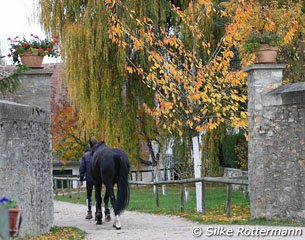
Only about 50 km from Paris lies the idyllic village of Autouillet with its traditional stone houses. Coming from the home of my Swiss friend Joy, who lives in the Paris inner-city suburb of Neuilly-sur-Seine, this quiet village
provides a stark contrast. “La Panetiere”, the property of Catherine and Michel Henriquet, is located on the outskirts of Autouillet, close to the forest.
I jump out of the car to press the button of the enterance door which opens and gives view on nothing but fields where horses graze peacefully. Left to us is a small outdoor arena and a lunging circle, but when we turn right we see three Iberian horses being trained in an Olympic size outdoor arena.
We park the car behind the indoor arena and a funny Pug and a Yorkshire terrier welcome us barking wildly. They turn out to be friendly fellows. A huge Rhodesian Ridgeback walks through the entrance to the outdoor arena which is between two impressive stone columns. He wags his tail enthusiastically; what a nice doggy welcome!
It is the first day Catherine and Michel Henriquet are back home after some days in Spain and the horses are in work again. Catherine Henriquet sits on a dark bay Lusitano stallion, Olympe du Plessis, and talks to her husband Michel who sits in a wooden hut. My friend and me introduce ourselves and Monsieur Henriquet invites us to sit next to him in the hut which has a heater and a loudspeaking system so that he is heard by his students. I ask if I am allowed to take photos everywhere and move along the outdoor arena. M. Henriquet nods: “Of course. The horses shouldn’t mind and if they do they'll have to learn to accept it.” Unfortunately though an old Latin student in high school, I notice my French is quite limited and M. Henriquet does not speak English, so Joy has to translate all the time.
 Catherine leaves the arena and two young girls on a grey and a black Iberian remain to get instructions. I start taking pictures to check the light and best angles.
Catherine leaves the arena and two young girls on a grey and a black Iberian remain to get instructions. I start taking pictures to check the light and best angles.
The scenery is very beautiful: round box trees surrounding the outdoor arena and the nice village and peacefully grazing horses are in the fields behind. Autumn coloured leaves provide a warm impression, though the sky is slightly overcast.
I don’t understand every command, but it is obvious that M. Henriquet is a very demanding trainer. The girls have to work hard to get him near satisfaction and one time the Master jumps to his feet and runs over to demonstrate them how to ride a walk pirouette.
I am really impressed how agile and fit this man in his 80s can be and it proves that a passion like horses keeps people young.
A Passion for the Tradition of Légèreté
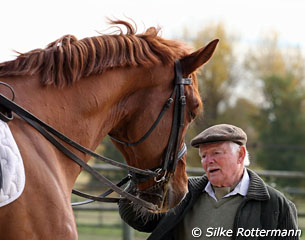 His passion started more than half a century ago when M. Henriquet was looking for a master of equitation in the classical principles displayed by the School of Versailles in the 18th century. His search led him to Nuno Oliveira in Portugal. It was the beginning of a life-long friendship between both similarly aged men and M. Henriquet trained with him every two months until Oliveira’s death in 1989.
His passion started more than half a century ago when M. Henriquet was looking for a master of equitation in the classical principles displayed by the School of Versailles in the 18th century. His search led him to Nuno Oliveira in Portugal. It was the beginning of a life-long friendship between both similarly aged men and M. Henriquet trained with him every two months until Oliveira’s death in 1989.
Even in the first few minutes one can recognise that M. Henriquet’s approach to dressage is quite different from most dressage trainers. For Henriquet the ultimate aim is “lightness” or what the French call “légèreté”. It is the hallmark of the so called “French school” and the word has become modern over the past years, especially, in Germany. What does it mean? To M. Henriquet “lightness” is when a horse is so collected and relaxed that it reacts to the finest of aids, moving with self-carriage which enables the rider to ride on loose or even dropped reins if desired.
As the girls, one French and one from South Africa, still try to please their master Catherine comes back from a short hack on a compact and rather heavier type of Lusitano, the 10 years old gelding Vendaval.
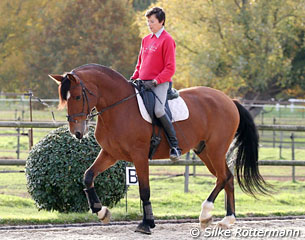 “I always hack my horses in the forest about 10 – 20 minutes before working them. It warms them up a bit and it’s good for their moral,” she tells me. She dismounts, takes a fork and heads to some manure, pulling the bay behind her. I am impressed how very relaxed this horse is and mention it. Catherine smiles: “Oh yes, he is.” She seems to be surprised because it appears to be the most natural thing for her. Her husband explains: “For us it is very important the horse is relaxed in his work from the start. It is not the result of working a horse, but the premise.”
“I always hack my horses in the forest about 10 – 20 minutes before working them. It warms them up a bit and it’s good for their moral,” she tells me. She dismounts, takes a fork and heads to some manure, pulling the bay behind her. I am impressed how very relaxed this horse is and mention it. Catherine smiles: “Oh yes, he is.” She seems to be surprised because it appears to be the most natural thing for her. Her husband explains: “For us it is very important the horse is relaxed in his work from the start. It is not the result of working a horse, but the premise.”
Catherine starts working Vendaval in a wider frame, but elevates him more the following minutes. What is remarkable is the contentment of the horse in general and the absence of any tension. Recently gelded Vendaval works exemplary from behind in all the exercises. Now and then Catherine interrupts the work and halts the horse, waits for some time and continues. “As soon as we feel the slightest tension we do this to relax the horse again and to concentrate them”. Lateral work is practised extensively in all gaits and when the horse did something very well there is not the usual strong patting, but a reprise of walk to reward the horse.
Vendaval, who is worked at Grand Prix level, demonstrates the “lightness” in the piaffe when Catherine gives him the reins and he still remains uphill. In the meantime a young man with a beautiful black warmblood gelding has joined Catherine and Vendaval in the outdoor arena. It is a completely different type of horse, less sturdy and definitely more blood-influenced.
Laissez Faire, New Star for Catherine
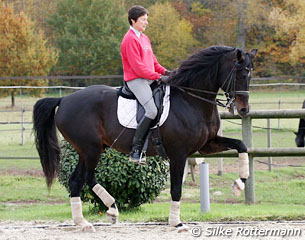 I return from the opposite end of the outdoor arena to the hut in which M. Henriquet and Joy sit together while the old and very friendly Rhodesian Ridgeback observes the scenery. I don't need to ask, M. Henriquet immediately introduces me to the black: “This is Whisper. We bought him only two months ago from a student. He is by Gribaldi and we have great faith in him.”
I return from the opposite end of the outdoor arena to the hut in which M. Henriquet and Joy sit together while the old and very friendly Rhodesian Ridgeback observes the scenery. I don't need to ask, M. Henriquet immediately introduces me to the black: “This is Whisper. We bought him only two months ago from a student. He is by Gribaldi and we have great faith in him.”
The 7-year old KWPN has the typical head of Gribaldi offspring. He moves smoothly and is ridden with lots of rhythm by a young serious-looking man. Victor Euwer has trained for three years with the Henriquets and seems to be one of the few who can “feel” and listen to a horse. There is no force at all in the training of this highly talented horse, everything’s focused on the fact that he stays relaxed and supple. M. Henriquet stands up and practises the first beginnings of piaffe with Whisper. There is no pulling at the reins or pressing with the calves, instead the horse is allowed to listen to the skilful touching with the whip. The gelding tries hard to show first steps and M. Henriquet seems to be satisfied. All he and his wife do happens in a completely calm and concentrated manner and this attitude is reflected in their horses.
Catherine dismounts Vendaval, who is then guided to his field behind the outdoor arena by a girl. She mounts her next ride: Laissez Faire. Though she never appears in a hurry in her equine work Catherine has to work efficiently during the morning to get all her riding done. As a dermatologist with her own practise in which she works in the afternoons, she needs to have the horses done by lunch time. She and her husband are supported by three girls and a man who do all the work necessary on a property like this.
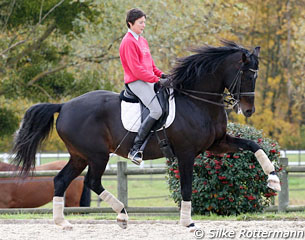 An important part of the Henriquets' training is working the horses in hand with a cavesson over the bridle with leather side reins attachedand a long lunge line which is linked to the cavesson. Catherine uses the rather small, but beautifully designed indoor arena for this. The hall is 40 metres long and 16 metres wide and its walls consist of the same bright stones like all the buildings on the property. In a small room people can sit down and watch the action going on. Framed photographs of their dearest horses decorate the walls.
An important part of the Henriquets' training is working the horses in hand with a cavesson over the bridle with leather side reins attachedand a long lunge line which is linked to the cavesson. Catherine uses the rather small, but beautifully designed indoor arena for this. The hall is 40 metres long and 16 metres wide and its walls consist of the same bright stones like all the buildings on the property. In a small room people can sit down and watch the action going on. Framed photographs of their dearest horses decorate the walls.
When we join Catherine she lunges the leggy Laissez Faire on the cavesson in a forward trot. The horse is born in my area in South Germany. Sired by Lacino and a out of a dam by Landgraf I, Laissez Faire was bred in Baden-Württemberg and is an attractive licensed stallion. Catherine bought him as a 5-year old in Germany and has trained him up to Grand Prix.
It's amazing to see how the dark bay horse immediately breaks from an extended trot into a halt as soon as Catherine puts the whip in front of him. Laissez Faire puts his hind legs clearly under his body before he continues in trot.
Then the stallion is asked to piaffe in hand. Catherine stands next to him and the horse obediently starts to piaffe. By snapping the whip on the ground she animates him to show more elevated steps and Laissez Faire reacts with a most expressive classical piaffe and is rewarded with a pat. One time the stallion rears a bit, but Catherine stays calm and sends him immediately and determinedly backwards before restarting their work like nothing has happened.
In the outdoor arena Laissez Faire appears even more impressive. He is very different to the Lusitano horses his rider has worked before. A modern warmblood standing well over 170 cm and a typical representative of a dressage horse desired nowadays.
The Modern Dressage Horse
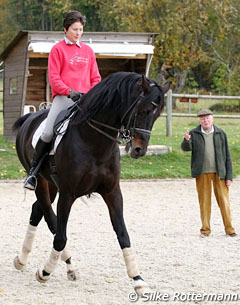 I ask M. Henriquet if he prefers Iberian horses since his wife has had her greatest successes with Lusitano bred horses and they may appear to be more suitable for the riding in the tradition of the légèreté. He denies it: “No, actually I have trained all kinds of horses over the past decades, also Selle Francais or thoroughbreds. It is only that I have very good contacts to breeders in Spain and Portugal through my friendship with Nuno Oliveira and Alvaro Domeq. Through these we were able to buy very good Iberian horses at affordable prices. Moreover many of the German horses in the 1960s and 1970s -- heavy sturdy types -- were less suitable for my kind of training. Today warmblood breeding is so refined that there actually is no real difference in training these horses, but good ones are are extremely expensive today. Sadly success in sport very often depends on financial possibilities.”
I ask M. Henriquet if he prefers Iberian horses since his wife has had her greatest successes with Lusitano bred horses and they may appear to be more suitable for the riding in the tradition of the légèreté. He denies it: “No, actually I have trained all kinds of horses over the past decades, also Selle Francais or thoroughbreds. It is only that I have very good contacts to breeders in Spain and Portugal through my friendship with Nuno Oliveira and Alvaro Domeq. Through these we were able to buy very good Iberian horses at affordable prices. Moreover many of the German horses in the 1960s and 1970s -- heavy sturdy types -- were less suitable for my kind of training. Today warmblood breeding is so refined that there actually is no real difference in training these horses, but good ones are are extremely expensive today. Sadly success in sport very often depends on financial possibilities.”
One might wonder how on earth do the Henriquets combine their vision of dressage, strongly influenced by the old masters' principles, with competing in the modern dressage world? In fact Catherine only began competing as a 33-year old at the end of the 1980s when Colonel Christian Carde, the former leader of the Cadre Noir in Saumur, international judge and competitor, once saw her Lusitano gelding Orphée RBO.
Carde strongly advised her to show this fantastic horse and so Catherine started a career which led her to winning the French championship title in 1991 and to the Olympic Games in Barcelona in 1992, where Orphée was the first Iberian horse ever to become an Olympian.
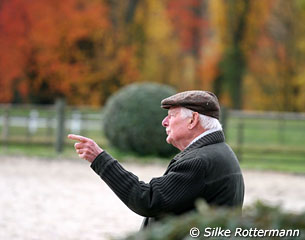 Since then Catherine and her husband have participated in international competitions with several horses, such as Spartacus, Carinho des Noes or Poejo, trained according to the classical principles. Of course the modern dressage sport requires some modifications in presenting the horse: The pinnacle of the Légèretè, riding the most difficult exercises on an almost loose rein (with the horse sitting deeply on its haunches) like Oliveira demonstrated on many beautiful photographs is not wished for at international competitions. Instead the judges wish to see a steady yet light contact with the bit. Of course Catherine presents her horses with a stronger bit contact like that in competitions, but the lightness still shines through and the overall picture is one of rare elegance.
Since then Catherine and her husband have participated in international competitions with several horses, such as Spartacus, Carinho des Noes or Poejo, trained according to the classical principles. Of course the modern dressage sport requires some modifications in presenting the horse: The pinnacle of the Légèretè, riding the most difficult exercises on an almost loose rein (with the horse sitting deeply on its haunches) like Oliveira demonstrated on many beautiful photographs is not wished for at international competitions. Instead the judges wish to see a steady yet light contact with the bit. Of course Catherine presents her horses with a stronger bit contact like that in competitions, but the lightness still shines through and the overall picture is one of rare elegance.
M. Henriquet beams when he tells us: “Once an international judge wrote on the protocol ‘Thank you for the elegance!’ And naturally it’s false to think that horses ridden in the tradition of the légèreté are not ridden with a bit contact. Of course they are, a steady soft contact, but a less strong one.
Laissez Faire honours his name when he starts working seriously. His long, slightly curled mane fly in the clear rhythm of his uphill canter and he gives a first glimpse of what he is capable of. I'm astonished when Catherine asks him to do piaffe and passage. In these two exercises the dark bay stallion shouldn't fear Totilas at all: he has the same shoulder freedom and sits well on his hind legs, showing most elevated expressive steps.
Life at La Panetiere
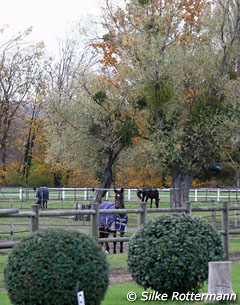 Laissez Faire is not only observed by us and the Henriquets’ old Ridgeback dog, but also by his stable companion Vendaval. This bright bay Lusitano looks from his field just behind, having rolled on the wet ground and looking very happy. In the field nearby there is a huge Lusitano, which stands 172 cm according to M. Henriquet. He is a relative of Catherine’s internationally successful horse Carinho des Noes. She explains that one reason why she and her husband had bought the beautiful estate 11-years ago was that 25 ha of land belonging to it.
Laissez Faire is not only observed by us and the Henriquets’ old Ridgeback dog, but also by his stable companion Vendaval. This bright bay Lusitano looks from his field just behind, having rolled on the wet ground and looking very happy. In the field nearby there is a huge Lusitano, which stands 172 cm according to M. Henriquet. He is a relative of Catherine’s internationally successful horse Carinho des Noes. She explains that one reason why she and her husband had bought the beautiful estate 11-years ago was that 25 ha of land belonging to it.
“On the property we trained before we only had very limited space to turn the horses out. Here we have more than 20 fields and paddocks for our horses and the ones of our boarders. All of our horses are turned out about half a day all year round, no matter what kind of weather we have. It is very good for their mind and moral. Only Paradis Zauber, after having had two rather serious injuries when being turned out, is not allowed to run freely anymore. Our vet and farrier both strongly advised us to do so. Instead he gets extensive walking with one of the girls.”
The horse Catherine mentioned is the last one she trains today. It is a 10-year old Sachsen-Anhalt bred gelding by Paradiesvogel, a huge leggy and elegant horse which matches the tall Catherine perfectly. Just when both entered the arena the telephone in the hut rings and horse and rider hurry there. Catherine stands in the hut and takes the phone while “Paradis” as she calls him waits patiently and undisturbed at the edge of the arena. He then follows her to the middle and stands quietly behind her until his rider finished her talk. It is great to witness this relaxation and patience, although my eye is mainly used to modern dressage with its more tense and affected movements. It seems that I have to get used to this pleasantly different picture.
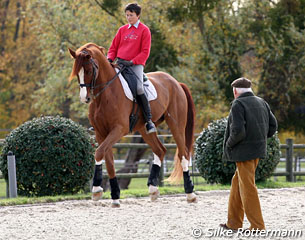 Catherine rides all her horses with noticeably deep, soft and quiet hands and starts working Paradis in trot. She does not warm up a very long time as the horses have already been hacked or worked in hand before, but she soon starts working more seriously. In between she walks the clipped bright chestnut to give him a breather. I stop photographing and talk to Catherine. Paradis has just won a national Grand Prix and is her greatest hope for the future. “He is still green as it is his first Grand Prix season. I intend to start him at his first CDI show next year.” I want to know if Catherine still aims for bigger events like Olympic Games. She smiles a bit shyly and answers: “Yes, I would like to represent France once again. But we have to wait and see.”
Catherine rides all her horses with noticeably deep, soft and quiet hands and starts working Paradis in trot. She does not warm up a very long time as the horses have already been hacked or worked in hand before, but she soon starts working more seriously. In between she walks the clipped bright chestnut to give him a breather. I stop photographing and talk to Catherine. Paradis has just won a national Grand Prix and is her greatest hope for the future. “He is still green as it is his first Grand Prix season. I intend to start him at his first CDI show next year.” I want to know if Catherine still aims for bigger events like Olympic Games. She smiles a bit shyly and answers: “Yes, I would like to represent France once again. But we have to wait and see.”
While watching her practise piaffe on the gelding with his charming forelock and big dark eyes reminding me of a pure Arab, one can see once more that the contact with the mouth is very light. The horse may be close to or even at the vertical now and then, but it’s still something very different to the elevation many wrongly trained horses show.
For the Henriquets this elevation is the logical result of something they call “rassembler”. This means the state of collection in which the horse is perfectly balanced, lowers its hind legs and lifts the shoulders. Has a horse reached this level of training the elevation (“ramener”) comes as close as possible to the vertical.
This is the self- carriage in which the horse allows the rider to drop the reins and still show the haute école. By contrast some of the horses in international dressage are in or even behind the vertical because they have been working the other way round, from front to hind end, and these do not show any self-carriage at all.
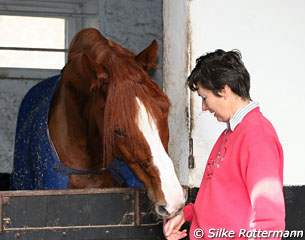 Paradis is walked back to the stables with not one wet hair. The farm consists of three stable buildings with 40 stalls which permanently house 33 horses. While Heading towards Paradis' stall we pass Laissez Faire. He is guided to his field by one of three working students and follows her well-mannered in a halter. Catherine tells us that she intends to sell some of her horses so she has just two to three to concentrate on. Time is becoming rare with her training her horses and students at home, giving clinics, attending shows and working in her office.
Paradis is walked back to the stables with not one wet hair. The farm consists of three stable buildings with 40 stalls which permanently house 33 horses. While Heading towards Paradis' stall we pass Laissez Faire. He is guided to his field by one of three working students and follows her well-mannered in a halter. Catherine tells us that she intends to sell some of her horses so she has just two to three to concentrate on. Time is becoming rare with her training her horses and students at home, giving clinics, attending shows and working in her office.
Paradis is in his box in the historic stable building. Obviously he has just rolled because his blanket is covered with shavings and water drops fall from his muzzle when he turns to us and welcomes Catherine with ears pricked, gently licking the back of her hand.
Once again I mention the natural understanding the Henriquets have with their horses. They regard horses as horses and earn their respect by treating them like what they are: animals. It is a nice difference in an equine world today in which horses are increasingly regarded as human beings and treated in a way they cannot understand.
A Quick Chat to End the Day
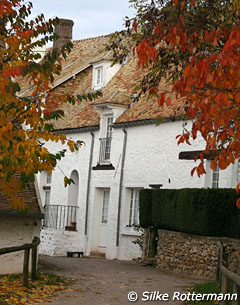 Catherine invites us to come into the house so we can talk a little bit before she has to rush off to her doctor’s office. Joy and me are impressed with the way this 16th century house is decorated inside. We sit down in the huge living room which has a giant fireplace and on the opposite some steps leading to a row of floor-to-ceiling high bookshelves. M. Henriquet talks about his time with Nuno Oliveira and I tell him that in Germany different people claim to teach and train in the tradition of the légèreté and some do it with tremendous commercial success.
Catherine invites us to come into the house so we can talk a little bit before she has to rush off to her doctor’s office. Joy and me are impressed with the way this 16th century house is decorated inside. We sit down in the huge living room which has a giant fireplace and on the opposite some steps leading to a row of floor-to-ceiling high bookshelves. M. Henriquet talks about his time with Nuno Oliveira and I tell him that in Germany different people claim to teach and train in the tradition of the légèreté and some do it with tremendous commercial success.
He shakes his head and becomes surprisingly emotional: “Some of these guys are no good.” Though the Henriquets are highly respected dressage trainers in France and also abroad they are amateurs. M. Henriquet was a managing director at a business in Paris for decades and he had to steal time for the horses after a long day in the office. Catherine, who began riding as a child and started to train with her husband as a 16-year old, studied from 18 to 27 and has worked as a dermatologist ever since.
“Dressage today demands a certain financial background. Even at a young age talented horses cost an awful lot these days. If you cannot afford them you have a disadvantage no matter how well you train the horse. To buy young talents we always need to sell some other horses,” M. Henriquet admits.
 I find it interesting how judges react to Catherine’s riding style. “Of course I have to assimilate to the FEI regulations and ride with a stronger bit contact and more impulsion in competition,” Catherine stresses. Her husband adds: “As we work the horses in a way without any force and pay much attention that they are round and relaxed, it looks less spectacular. But still you can have success with it and the elegance the horses express is well noticed.”
I find it interesting how judges react to Catherine’s riding style. “Of course I have to assimilate to the FEI regulations and ride with a stronger bit contact and more impulsion in competition,” Catherine stresses. Her husband adds: “As we work the horses in a way without any force and pay much attention that they are round and relaxed, it looks less spectacular. But still you can have success with it and the elegance the horses express is well noticed.”
In the early afternoon Joy, who had been very busy serving as an interpreter that day, and I left a world where we noticed a kind of dressage that was a consolation to the many ugly pictures us, friends of this sport, have seen so often over the past few years.
Merci beaucoup!
Text and Photos © Silke Rottermann for Eurodressage.com
Related Links
Orphee RBO, Iberian Trail Blazer
Allege Ideal: International Dressage & Equitation Association for Lightness